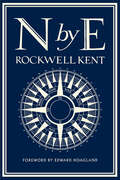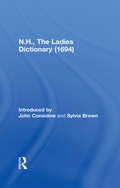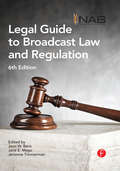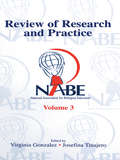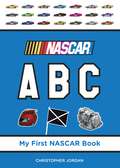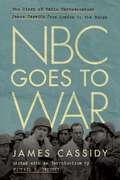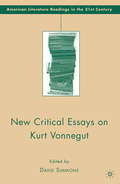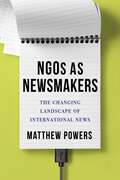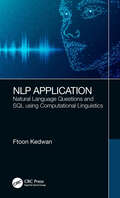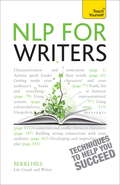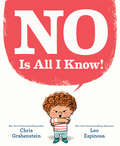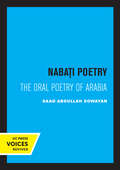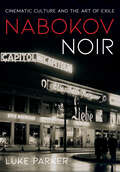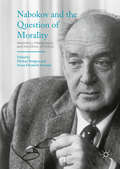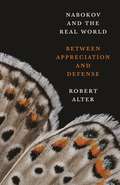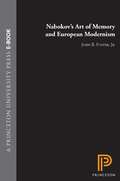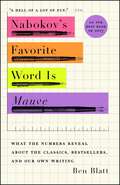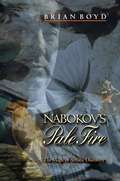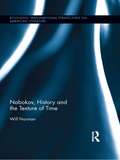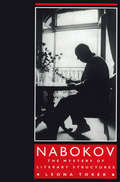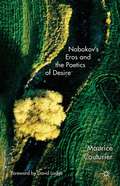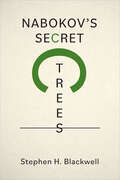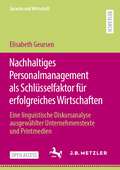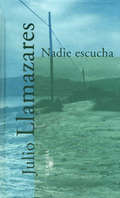- Table View
- List View
N by E
by Rockwell KentA classic tale of seafaring, shipwreck, and survival, reprinted from Wesleyan University Press's 1978 facsimile of the original. When artist, illustrator, writer, and adventurer Rockwell Kent first published N by E in a limited edition in 1930, his account of a voyage on a 33-foot cutter from New York Harbor to the rugged shores of Greenland quickly became a collectors' item. Little wonder, for readers are immediately drawn to Kent's vivid descriptions of the experience; we share "the feeling of wind and wet and cold, of lifting seas and steep descents, of rolling over as the wind gusts hit," and the sound "of wind in the shrouds, of hard spray flung on a drum-tight canvas, of rushing water at the scuppers, of the gale shearing a tormented sea." When the ship sinks in a storm-swept fjord within 50 miles of its destination, the story turns to the stranding and subsequent rescue of the three-man crew, salvage of the vessel, and life among native Greenlanders. Magnificently illustrated by Kent's wood-block prints and narrated in his poetic and highly entertaining style, this tale of the perils of killer nor'easters, treacherous icebergs, and impenetrable fog—and the joys of sperm whales breaching or dawn unmasking a longed-for landfall—is a rare treat for old salts and landlubbers alike.
N.H., The Ladies Dictionary (1694)
by Sylvia Brown John ConsidineThe ladies dictionary, being a general entertainment for the fair-sex was published on 19 March 1694 by John Dunton. No compiler was named on the title page, but the dedication by 'the author' addressed 'to the Ladies, Gentlewomen, and Others, of the Fair-Sex' was signed 'N. H.' The book offers around 1950 lexical and encyclopaedic entries, the great majority excerpted either verbatim or with some degree of abridgement or adaptation from other published books. It was the first substantial reference book to be published in England with women as its principal target audience, and was arguably the first alphabetically-arranged encyclopaedia to be published in English. The editor's introduction in this edition starts with an overview of the publisher John Dunton, and goes on to discuss the compilers of LD; its sources; its editing, printing and proof-reading; and its advertising, publication and afterlife. It concludes with lists of primary and secondary sources (including all the identified sources of LD). The reproduction of the dictionary that follows is from the Robert H. Taylor collection at Princeton. Because LD is irregularly alphabetized, the reproduction is followed by a new index of entries in strict alphabetical order, with their sources identified.
NAB Legal Guide to Broadcast Law and Regulation
by Jean Benz Jane E. Mago Jerianne TimmermanTo guide the industry in the 21st century, counsel for the National Association of Broadcasters (NAB) and leading attorneys have prepared the only up-to-date, comprehensive broadcast regulatory publication: NAB’s Legal Guide to Broadcast Law and Regulation. Known for years as the "voice" for broadcast law, this publication addresses the full range of FCC regulatory issues facing radio and television broadcasters, as well as intellectual property, First Amendment, cable and satellite, and increasingly important online issues. It gives practicing attorneys, in-house counsel, broadcasters and other communications industry professionals practical "how to" advice on topics ranging literally from "a" (advertising) to "z" (zoning). Now in its 6th edition, NAB’s Legal Guide to Broadcast Law and Regulation is available to keep you current on changes in the law, significant court decisions, FCC rules, agency policies and applied solutions. The National Association of Broadcasters is a nonprofit trade association that advocates on behalf of local radio and television stations and broadcast networks before Congress, the Federal Communications Commission and other federal agencies, and the courts.
NABE Review of Research and Practice: Volume 3
by Josefina Tinajero Virgina GonzalezThe National Association of Bilingual Education (NABE) published electronic issues of Volumes 1 and 2 of the NABE Journal of Research and Practice to offer archival records of 2002 and 2003 NABE conferences presentations. Beginning with Volume 3, the title of the publication is changed to NABE Review of Research and Practice and is published by Lawrence Erlbaum Associates, Inc. for NABE. NABE Review of Research and Practice, Volume 3 fulfills the following goals: *to establish an annual archival record of cutting-edge NABE conference presentations that generate new knowledge and advance the field of bilingual education research; *to mentor junior scholars within the academic setting by providing an outlet for developing a publication record with the assistance of established scholars, and by publishing guidelines for developing high-quality dissertation research proposals and completed studies, and for university-based efforts to mentor doctoral students in bilingual education;*to offer, in the Research section, an outlet for theoretical and applied research studies that represent innovative conceptual and philosophical perspectives, and that also implement innovative methodologies for solving theoretical and applied problems in bilingual education;*to provide, in the Applied Education/Action Research section, an outlet for case studies, position papers, and action research that comes from practitioners in the field of bilingual education who are implementing research methodologies in their own classrooms or school districts (e.g., teacher-based research, evaluation studies conducted in the implementation of bilingual education federal and state grants); and*to present, in the Position Papers and Reflections section, reflections of experiences of bilingual researchers, practitioners, and public school and higher education students that give insightful self-accounts of the experiences of ethnic minority students, scholars, and educators that allow readers to learn from them as role models and advocates. For further information on NABE conferences and publications visit the NABE Web page at www.nabe.org.
NASCAR ABC (My First NASCAR Racing Series #2)
by Christopher JordanAn exciting new NASCAR series for the youngest of racing fans. Introduce your children to the early basic concepts through the exciting world of NASCAR in this officially licensed NASCAR series.
NBC Goes to War: The Diary of Radio Correspondent James Cassidy from London to the Bulge (World War II: The Global, Human, and Ethical Dimension)
by James CassidyThe diary of radio correspondent James Cassidy presents a unique view of World War II as this reporter followed the Allied armies into Nazi Germany.James Joseph Cassidy was one of 362 American journalists accredited to cover the European Theater of Operations between June 7, 1944, and the war’s end. Radio was relatively new, and World War II was its first war. Among the difficulties facing historians examining radio reporters during that period is that many potential primary documents—their live broadcasts—were not recorded. In NBC Goes to War, Cassidy’s censored scripts alongside his personal diary capture a front-line view during some of the nastiest fighting in World War II as told by a seasoned NBC reporter.James Cassidy was ambitious and young, and his coverage of World War II for the NBC radio network notched some notable firsts, including being the first to broadcast live from German soil and arranging the broadcast of a live Jewish religious service from inside Nazi Germany while incoming mortar and artillery shells fell 200 yards away. His diary describes how he gathered news, how it was censored, and how it was sent from the battle zone to the United States. As radio had no pictures, reporters quickly developed a descriptive visual style to augment dry facts. All of Cassidy’s stories, from the panic he felt while being targeted by German planes to his shock at the deaths of colleagues, he told with grace and a reporter’s lean and engaging prose.Providing valuable eyewitness material not previously available to historians, NBC Goes to War tells a “bottom-up” narrative that provides insight into war as fought and chronicled by ordinary men and women. Cassidy skillfully placed listeners alongside him in the ruins of Aachen, on icy back roads crawling with spies, and in a Belgian bar where a little girl wailed “Les Américains partent!” when Allied troops retreated to safety, leaving the town open to German re-occupation. With a journalistic eye for detail, NBC Goes to War unforgettably portrays life in the press corps. This newly uncovered perspective also helps balance the CBS-heavy radio scholarship about the war, which has always focused heavily on Edward R. Murrow and his “Murrow’s Boys.”
NEW CRITICAL ESSAYS ON KURT VONNEGUT (American Literature Readings In The Twenty-first Century Ser.)
by David SimmonsKurt Vonnegut's darkly comic work became a symbol for the counterculture of a generation. From his debut novel, Player Piano (1951) through seminal 1960's novels such as Cat's Cradle (1963) and Slaughterhouse-Five (1969) up to the recent success of A Man Without A Country (2005), Vonnegut's writing has remained commercially popular, offering a satirical yet optimistic outlook on modern life. Though many fellow writers admired Vonnegut - Gore Vidal famously suggesting that "Kurt was never dull" - the academic establishment has tended to retain a degree of scepticism concerning the validity of his work. This dynamic collection aims to re-evaluate Vonnegut's position as an integral part of the American post-war cannon of literature.
NGOs as Newsmakers: The Changing Landscape of International News (Reuters Institute Global Journalism Series)
by Matthew PowersAs traditional news outlets’ international coverage has waned, several prominent nongovernmental organizations have taken on a growing number of seemingly journalistic functions. Groups such as Amnesty International, Human Rights Watch, and Médecins Sans Frontières send reporters to gather information and provide analysis and assign photographers and videographers to boost the visibility of their work. Digital technologies and social media have increased the potential for NGOs to communicate directly with the public, bypassing traditional gatekeepers. But have these efforts changed and expanded traditional news practices and coverage—and are there consequences to blurring the lines between reporting and advocacy?In NGOs as Newsmakers, Matthew Powers analyzes the growing role NGOs play in shaping—and sometimes directly producing—international news. Drawing on interviews, observations, and content analysis, he charts the dramatic growth in NGO news-making efforts, examines whether these efforts increase the organizations' chances of garnering news coverage, and analyzes the effects of digital technologies on publicity strategies. Although the contemporary media environment offers NGOs greater opportunities to shape the news, Powers finds, it also subjects them to news-media norms. While advocacy groups can and do provide coverage of otherwise ignored places and topics, they are still dependent on traditional media and political elites and influenced by the expectations of donors, officials, journalists, and NGOs themselves. Through an unprecedented glimpse into NGOs’ newsmaking efforts, Powers portrays the possibilities and limits of NGOs as newsmakers amid the transformations of international news, with important implications for the intersections of journalism and advocacy.
NLP Application: Natural Language Questions and SQL using Computational Linguistics
by Ftoon KedwanApplying Natural Language Processing (NLP) concepts to help humans in their daily life, this book discusses an automatic translation of an unstructured Natural Language Question (NLQ) into a Structured Query Language (SQL) statement. Using SQL as a Relational DataBase (RDB) interaction language, database administrators or general users with little to no SQL querying abilities are provided with all the knowledge necessary to perform queries on RDBs in an interactive manner. Key Features: Includes extensive and illustrative examples to simplify the discussed concepts Discusses a novel, and yet simple, approach to NLP Introduces a lightweight NLQ into SQL translation approach through the use of RDB MetaTables as a Hash table Extensive literature review and thorough background information on every tool, concept and technique applied Providing a unique approach to NLQ into SQL translation, as well as comprising disparate resources on NLP as a whole, this shortform book is of direct use to administrators and general users of databases.
NLP For Writers: Teach Yourself
by Bekki HillIn the only creative writing book to use NLP techniques, published writer Bekki Hill helps you to improve your narratives through the power of NLP. The focused, goal-orientated learning in this unique guide outlines step by step the different ways in which NLP can be used to develop a better mastery of character, plot and story by connecting emotionally with the reader.
NLP For Writers: Techniques to Help You Succeed
by Bekki HillIn the only creative writing book to use NLP techniques, published writer Bekki Hill helps you to improve your narratives through the power of NLP. The focused, goal-orientated learning in this unique guide outlines step by step the different ways in which NLP can be used to develop a better mastery of character, plot and story by connecting emotionally with the reader.
NO Is All I Know!
by Chris GrabensteinDo you know anyone like Oliver McSnow...who only knows the word NO?!Introducing a story about the AMAZING power of YES! This universally relatable picture book about toddlerhood from the New York Times bestselling team behind No More Naps! will elicit laughs from kids and their grown-ups everywhere!Oliver McSnow ONLY says NO. He says NO so much that his NO starts to grow. And grow and GROW...until that NO is out of control! No baths. No brushing teeth. No cleaning up. No bedtime! Morning, noon, and night—it&’s just NO, NO, NOOOOOOOOOO!But then Oliver's cousin visits. Jess loves the word YES. YES to friends! YES to food. YES to fun! YES, YES, YES, YES, YESSSSS! And suddenly, Oliver's world gets opened up in a most wonderful way!
Nabati Poetry: The Oral Poetry of Arabia
by Saad Abdullah SowayanThis title is part of UC Press's Voices Revived program, which commemorates University of California Press’s mission to seek out and cultivate the brightest minds and give them voice, reach, and impact. Drawing on a backlist dating to 1893, Voices Revived makes high-quality, peer-reviewed scholarship accessible once again using print-on-demand technology. This title was originally published in 1985.
Nabokov Noir: Cinematic Culture and the Art of Exile
by Luke ParkerNabokov Noir places Vladimir Nabokov's early literary career—from the 1920s to the 1940s—in the context of his fascination with silent and early sound cinema and the chiaroscuro darkness and artificial brightness of the Weimar era, with its movie palaces, cultural Americanism, and surface culture. Luke Parker argues that Nabokov's engagement with the cinema and the dynamics of mass culture more broadly is an art of exile, understood both as literary poetics and practical strategy.Obsessive and competitive, fascinated and disturbed, Nabokov's Russian-language fiction and essays, written in Berlin, present a compelling rethinking of modernist-era literature's relationship to an unabashedly mass cultural phenomenon. Parker examines how Nabokov's involvement with the cinema as actor, screenwriter, moviegoer, and, above all, chronicler of the cinematized culture of interwar Europe enabled him to flourish as a transnational writer. Nabokov, Parker shows, worked tirelessly to court publishers and film producers for maximum exposure for his fiction across languages, media, and markets. In revealing the story of Nabokov's cinema praxis—his strategic instrumentalization of the movie industry—Nabokov Noir reconstructs the deft response of a modern master to the artificial isolation and shrinking audiences of exile.
Nabokov and the Question of Morality
by Michael Rodgers Susan Elizabeth SweeneyThe first collection to address the vexing issue of Nabokov's moral stances, this book argues that he designed his novels and stories as open-ended ethical problems for readers to confront. In a dozen new essays, international Nabokov scholars tackle those problems directly while addressing such questions as whether Nabokov was a bad reader, how he defined evil, if he believed in God, and how he constructed fictional works that led readers to become aware of their own moral positions. In order to elucidate his engagement with aesthetics, metaphysics, and ethics, Nabokov and the Question of Morality explores specific concepts in the volume's four sections: "Responsible Reading," "Good and Evil," "Agency and Altruism," and "The Ethics of Representation. " By bringing together fresh insights from leading Nabokovians and emerging scholars, this book establishes new interdisciplinary contexts for Nabokov studies and generates lively readings of works from his entire career.
Nabokov and the Real World: Between Appreciation and Defense
by Robert AlterFrom award-winning literary scholar Robert Alter, a masterful exploration of how Nabokov used artifice to evoke the dilemmas, pain, and exaltation of the human conditionAdmirers and detractors of Vladimir Nabokov have viewed him as an ingenious contriver of literary games, teasing and even outsmarting his readers through his self-reflexive artifice and the many codes and puzzles he devises in his fiction. Nabokov himself spoke a number of times about reality as a term that always has to be put in scare quotes. Consequently, many critics and readers have thought of him as a writer uninterested in the world outside literature. Robert Alter shows how Nabokov was passionately concerned with the real world and its complexities, from love and loss to exile, freedom, and the impact of contemporary politics on our lives.In these illuminating and exquisitely written essays, Alter spans the breadth of Nabokov's writings, from his memoir, lectures, and short stories to major novels such as Lolita. He demonstrates how the self-reflexivity of Nabokov's fiction becomes a vehicle for expressing very real concerns. What emerges is a portrait of a brilliant stylist who is at once serious and playful, who cared deeply about human relationships and the burden of loss, and who was acutely sensitive to the ways political ideologies can distort human values.Offering timeless insights into literature’s most fabulous artificer, Nabokov and the Real World makes an elegant and compelling case for Nabokov's relevance today.
Nabokov's Art of Memory and European Modernism
by John Burt FosterDespite Vladimir Nabokov's hostility toward literary labels, he clearly recognized his own place in cultural history. In a fresh approach stressing Nabokov's European context, John Foster shows how this writer's art of memory intersects with early twentieth-century modernism. Tracing his interests in temporal perspective and the mnemonic image, in intertextual "reminiscences," and in individuality amid cultural multiplicity, the book begins with such early Russian novels as Mary, then treats his emerging art of memory from Laughter in the Dark to The Gift. After discussing the author's cultural repositioning in his first English novels, Foster turns to Nabokov's masterpiece as an artist of memory, the autobiography Speak, Memory, and ends with an epilogue on Pale Fire.As a cross-cultural overview of modernism, this book examines how Nabokov navigated among Proust and Bergson, Freud and Mann, and Joyce and Eliot. It also explores his response to Baudelaire and Nietzsche as theorists of modernity, and his sense of Dostoevsky, Tolstoy, and Pushkin as modernist precursors. As an approach to Nabokov, the book reflects the heightened importance of autobiography in current literary study. Other critical issues addressed include Bakhtin's theory of intertextuality, deconstructive views of memory, Benjamin's modernism of memory, and Nabokov's assumptions about modernism as a concept.
Nabokov's Favorite Word Is Mauve: What the Numbers Reveal About the Classics, Bestsellers, and Our Own Writing
by Ben BlattWhat are our favorite authors’ favorite words? Which bestselling writer uses the most clichés? How can we judge a book by its cover? Data meets literature in this playful and informative look at our favorite authors and their masterpieces. “A literary detective story: fast-paced, thought-provoking, and intriguing.” —Brian Christian, coauthor of Algorithms to Live ByThere’s a famous piece of writing advice—offered by Ernest Hemingway, Stephen King, and myriad writers in between—not to use -ly adverbs like “quickly” or “fitfully.” It sounds like solid advice, but can we actually test it? If we were to count all the -ly adverbs these authors used in their careers, do they follow their own advice compared to other celebrated authors? What’s more, do great books in general—the classics and the bestsellers—share this trait? In Nabokov’s Favorite Word Is Mauve, statistician and journalist Ben Blatt brings big data to the literary canon, exploring the wealth of fun findings that remain hidden in the works of the world’s greatest writers. He assembles a database of thousands of books and hundreds of millions of words, and starts asking the questions that have intrigued curious word nerds and book lovers for generations: What are our favorite authors’ favorite words? Do men and women write differently? Are bestsellers getting dumber over time? Which bestselling writer uses the most clichés? What makes a great opening sentence? How can we judge a book by its cover? And which writerly advice is worth following or ignoring? Blatt draws upon existing analysis techniques and invents some of his own. All of his investigations and experiments are original, conducted himself, and no math knowledge is needed to understand the results. Blatt breaks his findings down into lucid, humorous language and clear and compelling visuals. This eye-opening book will provide you with a new appreciation for your favorite authors and a fresh perspective on your own writing, illuminating both the patterns that hold great prose together and the brilliant flourishes that make it unforgettable.
Nabokov's Pale Fire: The Magic of Artistic Discovery
by Brian BoydPale Fire is regarded by many as Vladimir Nabokov's masterpiece. The novel has been hailed as one of the most striking early examples of postmodernism and has become a famous test case for theories about reading because of the apparent impossibility of deciding between several radically different interpretations. Does the book have two narrators, as it first appears, or one? How much is fantasy and how much is reality? Whose fantasy and whose reality are they? Brian Boyd, Nabokov's biographer and hitherto the foremost proponent of the idea that Pale Fire has one narrator, John Shade, now rejects this position and presents a new and startlingly different solution that will permanently shift the nature of critical debate on the novel. Boyd argues that the book does indeed have two narrators, Shade and Charles Kinbote, but reveals that Kinbote had some strange and highly surprising help in writing his sections. In light of this interpretation, Pale Fire now looks distinctly less postmodern--and more interesting than ever. In presenting his arguments, Boyd shows how Nabokov designed Pale Fire for readers to make surprising discoveries on a first reading and even more surprising discoveries on subsequent readings by following carefully prepared clues within the novel. Boyd leads the reader step-by-step through the book, gradually revealing the profound relationship between Nabokov's ethics, aesthetics, epistemology, and metaphysics. If Nabokov has generously planned the novel to be accessible on a first reading and yet to incorporate successive vistas of surprise, Boyd argues, it is because he thinks a deep generosity lies behind the inexhaustibility, complexity, and mystery of the world. Boyd also shows how Nabokov's interest in discovery springs in part from his work as a scientist and scholar, and draws comparisons between the processes of readerly and scientific discovery. This is a profound, provocative, and compelling reinterpretation of one of the greatest novels of the twentieth century.
Nabokov, History and the Texture of Time (Routledge Transnational Perspectives on American Literature)
by Will NormanThis book argues that the apparent evasion of history in Vladimir Nabokov’s fiction conceals a profound engagement with social, and therefore political, temporalities. While Nabokov scholarship has long assumed the same position as Nabokov himself — that his works exist in a state of historical exceptionalism — this study restores the content, context, and commentary to Nabokovian time by reading his American work alongside the violent upheavals of twentieth-century ideological conflicts in Europe and the United States. This approach explores how the author’s characteristic temporal manipulations and distortions function as a defensive dialectic against history, an attempt to salvage fiction for autonomous aesthetics. Tracing Nabokov’s understanding of the relationship between history and aesthetics from nineteenth-century Russia through European modernism to the postwar American academy, the book offers detailed contextualized readings of Nabokov’s major writings, exploring the tensions, fissures, and failures in Nabokov’s attempts to assert aesthetic control over historical time. In reading his response to the rise of totalitarianism, the Holocaust, and Cold War, Norman redresses the commonly-expressed admiration for Nabokov’s heroic resistance to history by suggesting the ethical, aesthetic, and political costs of reading and writing in its denial. This book offers a rethinking of Nabokov’s location in literary history, the ideological impulses which inform his fiction, and the importance of temporal aesthetics in negotiating the matrices of modernism.
Nabokov: The Mystery of Literary Structures
by Leona TokerVladimir Nabokov described the literature course he taught at Cornell as "a kind of detective investigation of the mystery of literary structures." Leona Toker here pursues a similar investigation of the enigmatic structures of Nabokov's own fiction. According to Toker, most previous critics stressed either Nabokov’s concern with form or the humanistic side of his works, but rarely if ever the two together. In sensitive and revealing readings of ten novels, Toker demonstrates that the need to reconcile the human element with aesthetic or metaphysical pursuits is a constant theme of Nabokov’s and that the tension between technique and content is itself a key to his fiction. Written with verve and precision, Toker’s book begins with Pnin and follows the circular pattern that is one of her subject’s own favored devices.
Nabokov’s Eros and the Poetics of Desire
by Maurice CouturierNabokov gained international fame with Lolita, a highly erotic and morally disturbing novel. Through its comprehensive study of the amorous and sexual behaviors of Nabokov's characters this book shows how Eros, both as a clown or a pervert, contributes to the poetic excellence of his novels and accounts for the unfolding of the plots.
Nabokov’s Secret Trees
by Stephen H. BlackwellIn nearly all his literary works, Vladimir Nabokov inscribed networks of trees to create meaningful patterns of significance around one or more of his passionate interests – in consciousness, memory, creativity, epistemology, ethics, and love, with a deep connection to nature serving as a constant undercurrent. Nabokov’s Secret Trees explores this neglected area of his art, one that positions nature as a hidden but vital core of his work. The book presents an entirely new, previously unsuspected Nabokov, one who crafts intricate patterns of arboreal imagery lurking behind his often-baroque psychological narratives. It reveals how Nabokov activates arboreal potentials by exploring the hidden ubiquity of trees, their essence as complex natural phenomena, and their role as quiet presences that have accompanied and fostered human civilization and art since their beginnings. The book uncovers how trees offer a rich and intricate field for structural, semantic, allusive, and metaphorical exploration. Based on the published corpus as well as archival materials, Nabokov’s Secret Trees demonstrates that trees not only populate Nabokov’s art in stunning, yet furtive, abundance, but also as mysterious natural entities, directly animating his works’ worlds and his readers’ experience of them.
Nachhaltiges Personalmanagement als Schlüsselfaktor für erfolgreiches Wirtschaften: Eine linguistische Diskursanalyse ausgewählter Unternehmenstexte und Printmedien (Sprache und Wirtschaft)
by Elisabeth GeursenMit diesem Open-Access-Buch liefert Elisabeth Geursen erstmals Erkenntnisse zum Nachhaltigkeitsbegriff im Personalmanagement, auf den mit „Human Capital“ oder „Human Ressource“ referiert wird, mithilfe primär linguistischer Methoden. Der Nachhaltigkeitsidee wird im deutschsprachigen und internationalen Kontext gesellschaftspolitische Relevanz zugewiesen. Geursen präsentiert im Bereich des gesellschaftlichen Diskurses um nachhaltiges Wirtschaften im Personalbereich prominente Themenkomplexe und deren diskurspezifische Verhandlung in ihrer zeitlichen Entwicklung über einen Zeitraum von 20 Jahren. Hervorzuheben ist der kontrastive Ansatz: Es wird die Themenentwicklung in den Geschäfts- und Nachhaltigkeitsberichten von drei branchenspezifischen Unternehmen, die hinsichtlich ihrer Nachhaltigkeitsaktivitäten besondere massenmediale Aufmerksamkeit erhalten, sowie in überregionalen Printmedien untersucht. Aus den Analyseergebnissen leitet Geursen Handlungsempfehlungen für Akteure ab und demonstriert damit einen starken Praxisbezug. Geursen gelingt eine Erweiterung bisheriger Nachhaltigkeitsforschung in einem wirtschaftswissenschaftlichen Themenfeld durch eine operationalisierte, theoretisch-fundierte diskurslinguistische und framebezogene Methodik (hier dem Verfahren nach Konerding entsprechend).
Nadie escucha (Alfaguara Ser.)
by Julio LlamazaresOpiniones, reportajes y artículos de viaje que revelan el pensamiento y la experiencia de un escritor que ha dado a la literatura española contemporánea algunas de sus mejores páginas. «Últimamente hay demasiado ruido. Si de alguna manera tuviera que definir la época en la que estamos viviendo, es como un tiempo en el que hay tanto ruido que nadie escucha a nadie, ni siquiera a sí mismo.» En medio de esta constatación escéptica, la prosa tranquila, amable y socarrona de Julio Llamazares resulta ser un lugar de descanso, un oasis ameno donde la palabra del autor se confunde con las reflexiones del lector, un regalo para todos aquellos capaces de escuchar a los demás sin dejar por ello de oírse a sí mismos. A esos lectores dedica el autor Nadie escucha.
